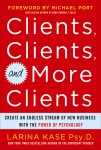 You’ve done all of the hard work of marketing…you’ve made connections and nourished them over time through social media and other keep in touch strategies. You’ve gotten to the point of talking about your product or service offerings with a prospective buyer, or have gotten them onto your website ready to buy… and then what happens?
You’ve done all of the hard work of marketing…you’ve made connections and nourished them over time through social media and other keep in touch strategies. You’ve gotten to the point of talking about your product or service offerings with a prospective buyer, or have gotten them onto your website ready to buy… and then what happens?
Nothing.
“What?” you wonder, surprised because the prospective client or customer seemed by all accounts ready and eager to buy.
You have all of these great products, programs, and services for people to choose from—you’ve even given them compelling names and packaged them like the sales and marketing gurus told you to.
So, what went wrong?
It’s simple; you offered too many choices or too much information.
“But wait, don’t people love choices?” you wonder. Yes, it’s true; we do love choice—up to a point. Beyond that point, we hit saturation and get mentally overloaded and unable to make a decision. The last thing we want to feel is stressed as we spend our money, so we consciously or unconsciously choose to do…
Nothing.
And what about information? Knowledge is power, right?
Yes, also true—up to a point. Psychology research shows that people actually do better with less information when making a complex purchasing decision, and generally do better with more information when making a simple purchasing decision.
If you’re curious why this is the case, it is because there are simply too many variables to consider with complex decisions. It is overwhelming. We start to think of all the other factors and fear not making the right decision. All of these emotions (stress, fear, anxiety) are not exactly conducive to buying.
So, if you’re in the business of selling something more complex than a vegetable peeler, less is actually more. (If you’re in the service or information product business, you’re definitely selling something more complex than a vegetable peeler!)
Okay, what should you do?
You want to give the optimal amount of choice and information. Research suggests that the optimal number of choices to give is between 3-6. I have not seen data on the optimal amount of information, but it is likely similar.
We can hold around 6 pieces of information in our minds (in working memory if you’re interested in that stuff). Much beyond that, we become flooded and can’t compare the information and basically want to move onto something less mentally taxing.
So, I would suggest providing a handful of key pieces of information. Be vigilant about the quality of the information and avoid vast generalities and exaggerated claims (which sound the distrust alarm). Stick to the facts and specific relevant details.
Go into the mind of your buyer
Put yourself in the position of the buyer and ask what you’d need to know to easily make the decision.
Better yet, conduct the research—give a sample of options and information to prospects and ask them to make a choice. Time how long it takes them to make a choice. Ask them to rate on a scale of 0-10 (0 = super easy, 10 = agonizing) how easy it was for them to make a decision. Ask them if the choices are different enough from each other that they could easily select the best option for them.
 When it doubt, simplify everything. Leonardo di Vinci has been quoted as saying, “Simplicity is the ultimate sophistication.” It is also likely your key to ultimate sales.
When it doubt, simplify everything. Leonardo di Vinci has been quoted as saying, “Simplicity is the ultimate sophistication.” It is also likely your key to ultimate sales.
How do you feel about simplicity? Have you found “less is more” in your sales process? Please share your thoughts in the comments below.

